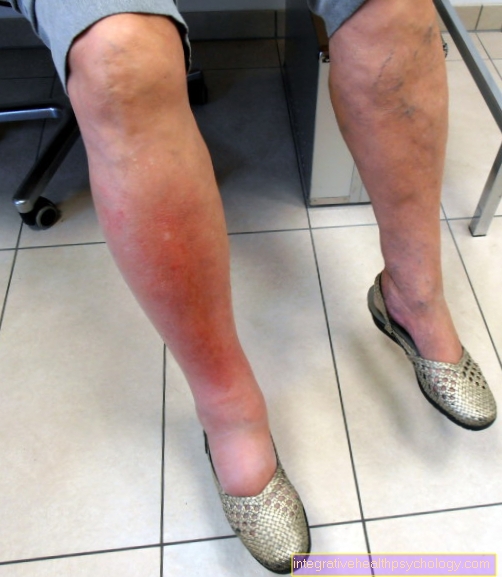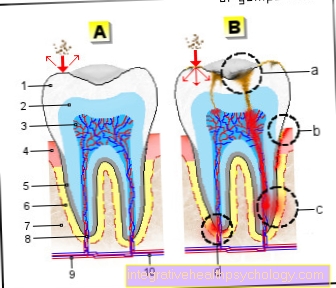The Morton's neuroma
What is Morton's neuralgia?
Morton's neuralgia, also known as Morton's metatarsalgia, is a progressive disease of the nerves that run on the underside of the foot to the individual toes.
Those affected complain of numbness when resting and pain when moving for a long time or when rolling the foot.

The reasons
Roughly speaking, the cause of the development is excessive stress or compression of the metatarsus. People who already suffer from a foot deformity are particularly susceptible. For example, patients with splayfoot symptoms or hallux valgus have a significantly higher risk of developing Morton's neuralgia.
However, the underlying pathomechanism has to be considered in a somewhat more differentiated manner. For example, too much pressure from a foot misalignment leads to the nerve being slightly compressed or rubbing against the bones of the foot from time to time. In response, a thicker layer of connective tissue forms around the nerve, which is supposed to serve to protect the nerve. But the nerve itself also begins to get thicker. However, the space in which the nerve can expand is limited, which means that the more the nerve tries to expand, the more and more compressed it is.
In addition to compression, other causes can also cause the nerve to want to expand due to damage. Every nerve is surrounded by tiny blood vessels to supply it with oxygen and energy. If this blood flow is disturbed, for example in the case of PAD (peripheral arterial occlusive disease), the nerve also reacts with an increase in thickness.
Most common in Germany, however, is nerve damage as a result of excessive compression of the nerve between the metatarsals.
Find out more about the topic here: Neuralgia.
You can recognize Morton's neuralgia by these symptoms
- Severe foot pain when walking for a long time
- Pain gets worse the more extreme the foot is rolled
- the pain radiates from the metatarsus to the toes
- simultaneous numbness in the foot
- Compression of the forefoot also triggers the pain
Pain as a symptom
The pain is not given right from the start of the disease, but only occurs when the nerve has already undergone a considerable increase in thickness. Most patients describe the pain as pointed and piercing.
The pain can be provoked by rolling extremely hard, which results in compression of the thickened nerve between the metatarsal bones, or by squeezing the forefoot from the sides with one hand, which also causes compression of the nerve between the bones.
Find out more about the topic here: Pain.
Numbness and tingling as a symptom
The numbness in the foot comes about because the nerves not only transport the perception of pain, but also information about pressure on the ball of the toes, the position of the foot in space and the tactile sensation of the feet. If the nerve is damaged, however, the transport of this information from the foot to the brain no longer works correctly and the feeling develops that the foot is numb or not fully in place.
On the other hand, however, damage to the nerve can also cause nerve impulses to be generated even though there is no reason to do so. These are then felt by the brain as tingling.
The diagnosis
The diagnosis is made up of the appropriate symptoms, the exclusion of other diseases and, in this case, correspondingly evidencing imaging.
In addition to pain when walking, coupled with numbness, the nature of the pain is a crucial indicator for a correct diagnosis. To secure this, however, the foot must be viewed either with an ultrasound machine or with an MRI. The thickening of the nerve can be made visible here.
What do you see of the foot in an MRI?
For any non-radiologist, evaluating the MRI image would likely be very difficult. With the MRI, individual "body slices" are considered, with the help of which one can look at the interior of the person in the corresponding area. A closer look reveals a thickened nerve between the metatarsals.
As a rule, only one nerve is affected - namely the one between the third and fourth metatarsal bones and is therefore the only one that is thickened. The remaining nerves thus give a good reference value to which one can refer and which represent the normal case.
Read more about the topic here: MRI of the foot.
Conservative therapy
Since Morton's neuralgia is not a malignant disease, conservative therapy should generally be given priority. Possible treatment concepts could be the use of insoles in combination with physiotherapy. With the help of these two adjusting screws, an attempt is usually made to correct the underlying foot deformity, which should also result in a relief of the pain.
If this approach is no longer sufficient or if a malalignment of the foot is not the causal problem, local anesthetics - i.e. locally effective narcotics - can be injected. The medication is distributed around the Morton's neuroma and prevents the pain from the foot from making its way to the brain. Furthermore, the local use of cortisone can suppress the body's immune reaction caused by irritation. The increase in thickness of the nerve is thus slowed down.
If the problem is already so advanced, however, the local anesthetics only ensure a few days of freedom from pain, so that an operation usually follows to eliminate the cause of the pain and not just combat the symptoms
How can you relieve the pain?
The first stage of therapy is usually injecting a local anesthetic into the appropriate area in the foot to block the nerve from transmitting pain. However, this does not provide permanent pain relief and lasts a maximum of a few days. This procedure can be repeated, but usually does not lead to the desired success, so that an operation for nerve swelling is usually the last resort.
In some circles, acupuncture is also said to have a pain-relieving effect. However, whether this is successful varies from person to person.
More information on the topic Local anesthetics - the local anesthetic you'll find here.
Can a cortisone injection help?
A cortisone injection can help, but it does so at the cost of certain side effects. However, a cortisone injection alone is not enough to stop the nerve from growing in thickness. Rather, cortisone injections have to be administered regularly, since the cortisone concentration drops over time. However, cortisone tends more than other drugs to also cause central side effects, which is why its use should be carefully considered.
The disease cannot be stopped with the administration of cortisone, which is why it is usually used in combination with a local anesthetic, which is supposed to relieve the pain, which cortisone is not able to do.
Read more about the topic here: Effects of cortisone.
insoles
As a rule, insoles represent the first conservative step in the treatment of pain in Morton's neuroma. They are able to correct a foot deformity that often precedes Morton's neuroma. Usually it is splayfoot syndrome, in which insoles help relieve the metatarsus and thus also give the affected nerves more room to move in without being irritated by the metatarsal bones.
As a rule, the health insurance company will cover the costs for the insoles, which is why this conservative treatment method should definitely be considered.
Find out more about the topic here Insoles.
Foot exercise
As a rule, foot gymnastics are prescribed for appropriately relieving insoles. Those affected are taught various exercises that serve to treat splayfoot syndrome.
But even people without a causal foot deformity can benefit from this by developing gaits together with a physiotherapist that relieve the metatarsus and thus contribute to pain reduction.
These home remedies can help
Depending on the underlying cause, there are a few home remedies that will help the body. If, for example, the cause is insufficient blood flow, warm foot baths can help. They stimulate your blood circulation again so that the nerve is better supplied with nutrients and oxygen.
However, if a foot misalignment or general nerve irritation is responsible, cold foot baths can bring some relief. Cold reduces the immune system and the inflammatory response that takes place in the nerve.
Even if not necessarily considered a home remedy, weight loss can bring about improvement in overweight patients. This means that there is less weight on the feet and the metatarsus can relax a little.
When do I need an operation?
An operation is the last step in the series of treatment options and is used when conservative treatment methods no longer show any effect.
As a rule, at some point the use of local anesthetics and cortisone will no longer be sufficient to maintain freedom from symptoms. Then surgery is recommended, with which the majority of those affected are relatively free of symptoms.
The duration
Morton's neuroma is a progressive disease. This means that it does not go away again, but can only tend to progress further. Admittedly, cortisone and proper equipment with insoles and foot gymnastics can curb the progress, but not stop it.
As a rule, the "disease" lasts until the corresponding nerve segment is removed during an operation. If the patient decides against the operation, he will have to get by for the rest of his life with Morton's neuroma and the more or less severe pain and numbness associated with it.




























